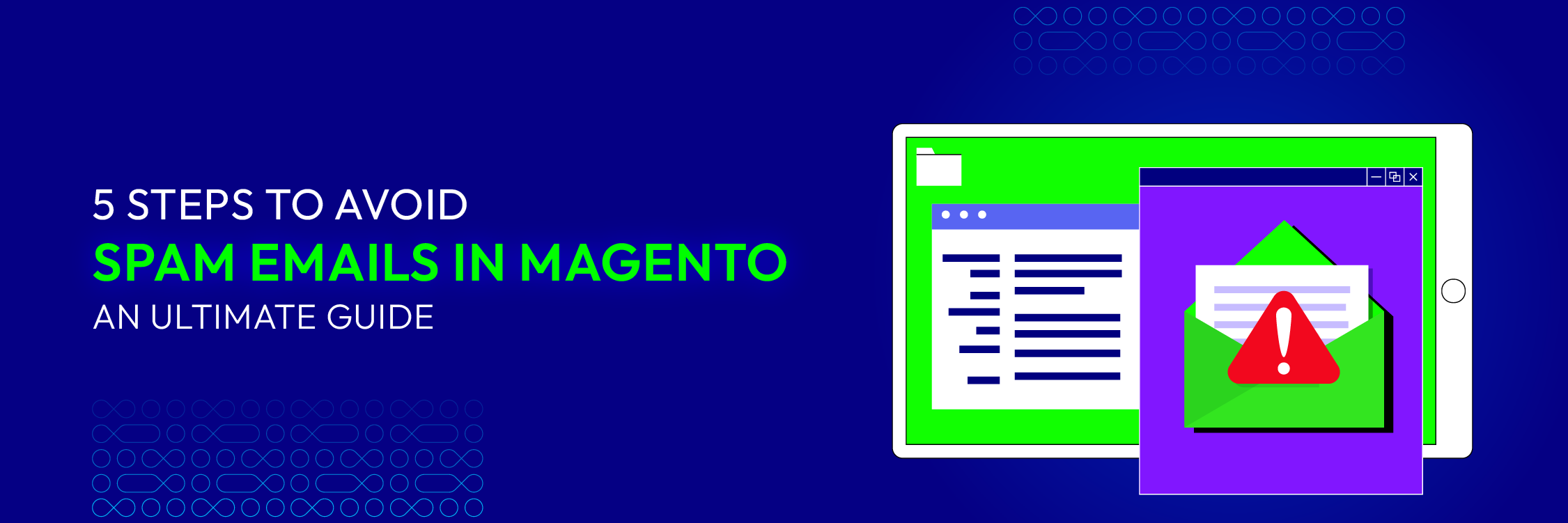5 Steps to Avoid Spam Emails in Magento: An Ultimate Guide

Wondering how to avoid spam emails in Magento 2?
Emails remain one of the most powerful tools to update customers about their orders, shipping, and store promotions. But if your Magento emails constantly land in the spam folder, they lose their value and hurt customer trust.
In this guide, we’ll break down the main reasons Magento emails are flagged as spam and share practical steps to fix them. With the right Magento 2 SMTP settings and smart configurations, you can boost deliverability, keep your messages out of spam, and ensure they reach the inbox every time.
Key takeaways
- Misconfigured Magento 2 SMTP settings are the #1 reason emails land in spam.
- Always set up SPF, DKIM, and DMARC to verify your domain.
- Avoid sudden email volume spikes by warming up new IPs gradually.
- Clean, well-structured email content lowers the chance of being flagged.
- The Mageplaza SMTP extension adds logging, testing, and integrations for better deliverability.
5 Common Reasons Magento 2 Emails End Up in Spam

Email providers use spam filters to block suspicious messages before they reach the inbox. These filters analyze different factors, such as:
- Content filters: check for spammy words, broken HTML, or excessive links.
- Blacklist filters: block emails sent from domains or IPs with poor reputation.
- Header filters: detect inconsistencies in email headers or SMTP transactions.
- Language/country & rule-based filters: flag unusual languages or specific messages that match predefined “banned” rules.
- Machine learning filters: learn from large datasets to predict and block new spam patterns.
- Source filters: check the authentication protocols (for example: SPF, DKIM, and DMARC) to identify frequently-changed domains and email addresses by spammers.
So why do Magento 2 emails often get into spam inbox? Here are top 5 reasons why:
- Misconfigured SMTP settings: Using default PHP mail or entering incorrect SMTP credentials can make your emails look untrustworthy. Correct Magento 2 SMTP settings ensure proper authentication and smoother delivery.
- Missing SPF, DKIM, or DMARC records: Without these DNS records, your domain can’t verify itself to email providers. This often leads to emails being marked as spam or rejected entirely.
- Poor sender reputation (IP/domain): If your server IP or domain has been blacklisted or flagged for suspicious activity, inbox providers will automatically downgrade or block your messages.
- High sending volume without warm-up: Sending large numbers of emails from a new IP or domain without gradually increasing volume can trigger spam filters. Warming up helps build trust.
- Unoptimized email content: Spammy phrases, excessive links, broken HTML, or missing headers can activate content filters. Clean, well-structured templates improve inbox placement.
💡Tips
The Mageplaza SMTP extension offers advanced configuration, testing, and logging tools to help identify these issues and keep your Magento 2 emails out of spam folders.
Steps to Avoid Spam Emails in Magento 2
Step 1: Maintain a Clean Domain Reputation
First and foremost, building a clean domain reputation is essential for convincing spam filters and ESPs of your authenticity, which in turn improves email delivery. Here’s how to establish a good domain reputation:
Comply with the CAN-SPAM Act
When sending emails through Magento, you must adhere to the rules and regulations set by the CAN-SPAM Act. This law ensures that email-sending activities remain ethical. To ensure your emails reach recipients’ inboxes, remember to:
- Avoid false or misleading information.
- Clearly label the message as an ad.
- Include the sender’s location.
- Respect recipients’ requests to opt out of future emails.
- Monitor how others represent your brand.
Use an Established Domain
If you’re using a new domain, opting for an established one can be beneficial. A domain with stability and longevity can enhance your reputation and increase the chances of your emails landing in the primary inbox.
Let’s take an example of how to set up a domain correctly:
✅ Correct: Evelyn@mageplaza.com
❌ Incorrect: Eve123xyz@gmail.com
Limit Emails Per Domain
The amount of emails you can send is limited by email service providers. Make sure your email campaigns adhere to these restrictions, as going over them could damage the reputation of your site.
Use Exclusive Domains for Specific Activities
Creating separate domains for different functions can help personalize your activities, streamline your workflow, and manage queries effectively, all while building a solid reputation over time. For example, having distinct domains for customer service, general information, and partnerships can prevent confusion and improve email domain management.
Step 2: Configure Servers and IPs

Use a Dedicated IP Address
Ensure you use a dedicated IP address instead of a shared one. Shared IPs can expose your email reputation to the risks of spammers using the same IP. A dedicated IP helps protect your email deliverability and optimizes your Magento conversion rates by avoiding the risk of being blocked due to others’ actions.
Configure Email Authentication: SPF, DKIM, and DMARC
- SPF (Sender Policy Framework): This layer verifies that emails from your domain are sent from your IP address, preventing spoofing.
- DKIM (DomainKeys Identified Mail): This involves a private key, public key, and signature in the domain’s DNS record to verify the sender’s authenticity.
- DMARC (Domain-based Message Authentication, Reporting & Conformance): This protocol often implemented by a top DMARC provider, executed with SPF and DMARC records, ensures emails are delivered to the primary inbox. SPF checks the sending IP’s authority to send emails for the domain, while DKIM uses cryptographic signatures to verify the message content’s integrity.
Utilize an SMTP Server
You can send emails on Magento using the Simple Mail Transfer Protocol (SMTP) by using a particular third-party SMTP service. With services like Gmail, Amazon, Microsoft, or any other mail server account, this makes it simple to send emails from one server to another.
With your server configured, you can move to the next step.
Step 3: Build Effective Email Structures for Magento Emails
Below is the recommended Email Structure to Avoid Spam in Magento.
Include a Plain Text Part
Magento typically sends only the HTML part of emails, which can increase the spam score. To improve compatibility and accessibility, manually create text parts for each email template or automatically generate them from the HTML version.
Adjust Quote-Printable Line Length
The standard quote-printable line length should be up to 998 characters to comply with the RDC 2822 specification and enhance readability. Magento’s default line length for print-quotable content is 200 characters, but you can adjust this value as needed.
Embed Images
Emails without images are more likely to be classified as spam. Enhance your email security by including at least one image in your message. However, avoid using images from external sources.
Use Valid HTML Structure

Work with an experienced HTML developer to ensure your email body has a well-structured HTML layout. Stick to simple HTML and tables, avoiding complex CSS3.
These are the main guidelines for formatting emails. Next, let’s move on to how to optimize your email content to avoid spam in Magento.
Step 4: Optimize Email Content for Magento
Valuable Text
Make sure the content in your emails is something your readers would actually find interesting. First, divide up your audience into several groups, then target each group with communications that are pertinent to them.
Avoid Spam Trigger Words
Terms like “discount,” “free,” and “buy now” frequently cause spam. They may draw attention, but they also make it more likely that your emails will be regarded as spam. Instead, take a customized strategy to ensure that your information is understandable and relatable.
Avoid Link Shorteners
While shortened links look cleaner, they can undermine trust and increase the chances of your emails being marked as spam. Use full, descriptive URLs to maintain transparency and authenticity with your recipients.
Use High-Resolution and Relevant Images
Include images in your emails to add value, but avoid using just one image or too many images. A single image can be seen as spam, and too many can dilute your message. Add a moderate number of high-resolution, relevant images to enhance your content.
Step 5: Test Email Messages
Use Third-Party Services
Before sending emails, it’s crucial to test them. Third-party services can help you evaluate the email’s spam score and provide previews on various platforms and devices. They also offer suggestions for improving your email’s HTML coding.
Review With Your Team
After creating an email in Magento, send it to your staff and teammates for feedback. Use their input to refine and enhance the quality and effectiveness of your email content.
Ensure Mobile Compatibility
Magento’s flexible design is crucial for reaching a wider audience, especially considering the significance of smartphones. Make sure your emails work well on mobile devices by testing them there.
Step 6: Warm Up Your Sending IP/Domain
If you’re starting fresh with a new domain or IP, gradually increase your email volume instead of sending bulk right away. This step helps build trust with email providers and avoids sudden spam flags.
Common Pitfalls & Limitations
Even when you’ve configured email settings correctly, there are a few common pitfalls that Magento store owners often face:
- Relying only on default SMTP: Since Magento 2.4.6, a built-in SMTP option is available, but it’s very limited. Without advanced features like authentication testing, error logs, or email history, problems can easily go unnoticed.
- Incomplete DNS records: Forgetting to add SPF, DKIM, or DMARC records means your domain can’t verify itself, so emails may still be flagged as spam or rejected.
- Shared hosting restrictions: Many hosting providers limit outgoing emails or assign you a shared IP. If that IP is already on a blacklist, your messages are more likely to be filtered.
- Sudden spikes in email volume: Sending thousands of messages at once (like newsletters or promotions) from a new IP can damage your sender reputation. Even transactional emails like order confirmations may be affected.
- Content issues: Overuse of spammy words, broken HTML, or missing headers can trigger filters even if SMTP is configured correctly.
💡 Tips
- Respect compliance rules: Always include an unsubscribe option in marketing emails and process opt-outs quickly.
- Keep your lists clean: Avoid purchased email lists and remove invalid addresses to protect your domain reputation.
- Use the right tools: Mageplaza SMTP extension provides advanced logging, testing, and integration with services like Mailgun or SendGrid to maximize inbox placement.
FAQs
1. How can I make sure emails from my Magento store aren’t tagged as spam?
Ensure that your server is configured correctly to prevent spam folders and send emails from your domain. To foster trust, keep up a good sender reputation, adhere to email authentication methods like SPF and DKIM, and think about employing a dedicated IP address.
2. For greater deliverability, is it preferable to integrate graphics in Magento emails?
It is advised to directly incorporate photos into your emails. When opposed to employing external image links, this method lowers the likelihood of spam classification. Make sure the HTML in your emails is organized properly and adheres to best practices for content.
3. What aspects of sending transactional or order status emails in Magento should I take into account to avoid spam?
When sending transactional emails, take into account things like using SPF and DKIM for authentication, conducting content analysis to remove phrases that could be construed as spam, and making sure your email server is configured correctly. By taking these precautions, emails are more deliverable and less likely to be regarded as spam.
4. Will using shortened links in my Magento emails impact email deliverability, or should I avoid doing so?
Shorter URLs should not be included in emails. Including complete, informative links promotes transparency and genuineness and allays worries that emails can be mistaken for spam.
5. In order to stop spam emails in Magento 2, how can store owners use email protection measures?
Owners of Magento stores can incorporate strategies for spam prevention and reputation building, such as adopting Magento CAPTCHA. OTP verification further increases security, while testing and validating email addresses on a regular basis lowers bounce rates.
6. Is it possible to enhance email delivery and prevent spam with a Magento extension?
Yes, by guaranteeing proper server configuration and providing email segmentation options, a Magento plugin can improve email deliverability. Supporting authentication standards like DKIM, DMARC, and SPF also lessens the possibility that emails will be categorized as spam.
7. How can I prevent email services from labeling my Magento mailings as spam?
Make sure your Magento mails are compliant with the CAN-SPAM Act by adding a simple unsubscribe button and informative content. Test newsletters frequently with third-party services to evaluate their cross-platform compatibility and spam ratings.
Conclusion
To understand how to prevent sending spam emails in Magento 2, it’s crucial for store owners to implement proactive strategies. This ensures that important emails like order confirmations consistently reach recipients’ inboxes, preserving a positive email reputation.
This article delves into the mechanics of spam filters in Magento, highlighting the importance of configuring servers and IPs for effective email delivery. It also outlines best practices aimed at minimizing the occurrence of sending and receiving spam emails within the Magento ecosystem.






![Top 20+ Must-have Shopify Apps for 2025 [Free & Paid] - Mageplaza](https://cdn2.mageplaza.com/media/blog/must-have-shopify-apps/top-must-have-shopify-apps.png)
![[2025 Updates] Top 10+ Upsell Apps for Shopify - Mageplaza](https://cdn2.mageplaza.com/media/blog/best-upsell-shopify-app/cover.png)